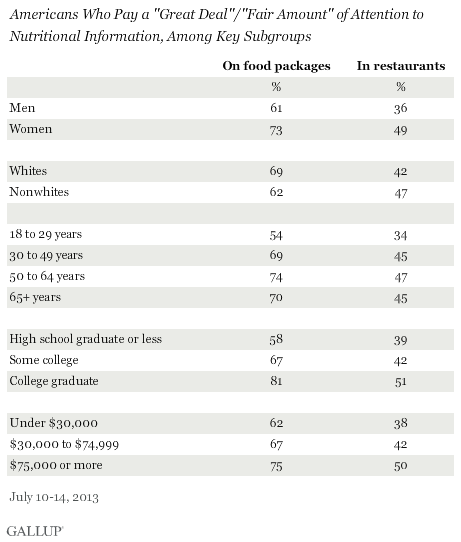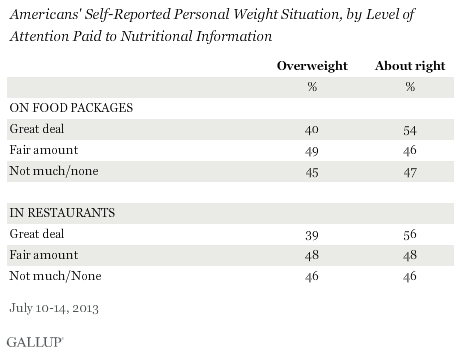WASHINGTON, D.C. -- Even as more U.S. restaurants list nutritional information on their menus, less than half of Americans, 43%, say they pay a "great deal" or a "fair amount" of attention to it. Americans are much more likely to take note of nutritional labels on food packages, with 68% saying they pay at least a fair amount of attention to this information.

These data, from Gallup's annual Consumption Habits survey, conducted July 10-14, come as some restaurants in the U.S. take steps to comply with a provision of the Affordable Care Act that requires restaurant chains with 20 or more locations to list calorie information on menus and menu boards by 2014. Other restaurants added nutritional information to their menus prior to the Affordable Care Act's passage in 2010 to meet city or state requirements, to be transparent with their customers about the nutritional content of their food, or to respond to pressure from health groups.
While menu labeling in restaurants is a new federal requirement, the federal government has required all packaged food to have nutritional labeling since 1990. As a result, Americans may be more accustomed to looking for nutritional information on packaged foods.
Men, Young Adults Less Likely to Pay Attention to Nutritional Information
There are some differences in the attention Americans pay to nutritional information among key demographic groups:
- Women are more likely than men to pay a great deal or fair amount of attention to nutrition information on food packages, 73% to 61%, and on restaurant menus, 49% to 36%.
- Young adults aged 18 to 29 are the age group least likely to say they pay attention to nutrition information.
- College graduates (81%) are the group most likely to say they pay attention to nutrition labels on food packages, exceeding those with some college (67%) and those with a high school diploma or less (58%). And the pattern is the same for nutrition information in restaurants.
- Lower-income Americans are less likely than middle- and higher-income Americans to say they pay attention to nutritional information on food packages and in restaurants.
- There are relatively minor differences by race.

Paying Attention to Nutritional Information Linked to Healthy Diet, Weight
Americans who say they pay a great deal of attention to the nutrition labels on food packaging are at least twice as likely as those who pay less attention to describe their diet as "very healthy." A similar pattern exists based on attention to nutrition information in restaurants.

Americans who pay a lot of attention to nutrition information are somewhat less likely than those who pay less attention to say they are overweight. Forty percent of those paying a great deal of attention to nutritional information on food packages say they are overweight, compared with 45% or more of those who pay less attention to that information. This same pattern exists among those who pay a great deal of attention to nutritional information in restaurants.

Implications
Although many large chain restaurants have already added nutritional information to their menus, less than half of Americans say they pay attention to this information. However, most Americans do pay attention to nutrition labels on packaged foods, which the federal government has required for 23 years.
Americans' level of attention to nutritional information in restaurants may increase as the practice of posting such information become more common. It is possible, though, that people are more flexible when eating out -- and more likely to choose less healthy food options -- than they are when deciding what to purchase at the grocery store.
Regardless, paying close attention to nutritional information on food packages and in restaurants could be a successful tool for Americans in managing their weight and maintaining a healthy diet. But simply paying attention to nutritional information is not enough to lower obesity rates. Americans must also use what they learn from the nutritional information to make healthier choices. Thus far, studies have shown mixed results as to whether posting nutritional information in restaurants actually encourages people to choose a healthier option.
Survey Methods
Results for this Gallup poll are based on telephone interviews conducted July 10-14, 2013, with a random sample of 2,027 adults, aged 18 and older, living in all 50 U.S. states and the District of Columbia.
For results based on the total sample of national adults, one can say with 95% confidence that the margin of sampling error is ±3 percentage points.
Interviews are conducted with respondents on landline telephones and cellular phones, with interviews conducted in Spanish for respondents who are primarily Spanish-speaking. Each sample of national adults includes a minimum quota of 50% cellphone respondents and 50% landline respondents, with additional minimum quotas by region. Landline and cell telephone numbers are selected using random-digit-dial methods. Landline respondents are chosen at random within each household on the basis of which member had the most recent birthday.
Samples are weighted to correct for unequal selection probability, nonresponse, and double coverage of landline and cell users in the two sampling frames. They are also weighted to match the national demographics of gender, age, race, Hispanic ethnicity, education, region, population density, and phone status (cellphone only/landline only/both, and cellphone mostly). Demographic weighting targets are based on the March 2012 Current Population Survey figures for the aged 18 and older U.S. population. Phone status targets are based on the July-December 2011 National Health Interview Survey. Population density targets are based on the 2010 census. All reported margins of sampling error include the computed design effects for weighting.
In addition to sampling error, question wording and practical difficulties in conducting surveys can introduce error or bias into the findings of public opinion polls.
View methodology, full question results, and trend data.
For more details on Gallup's polling methodology, visit www.gallup.com.
